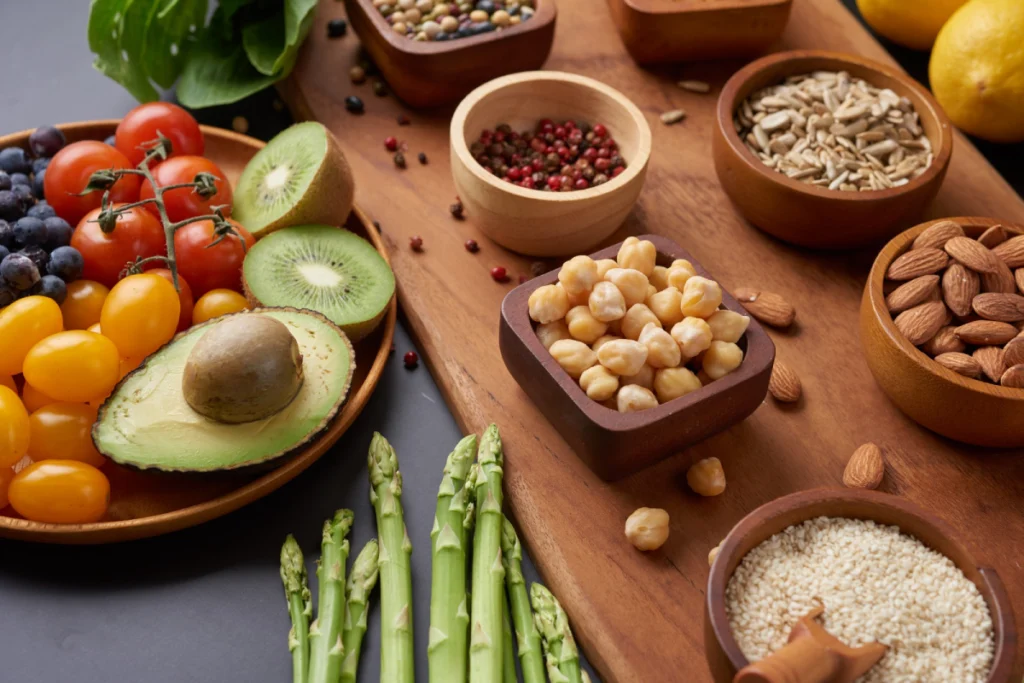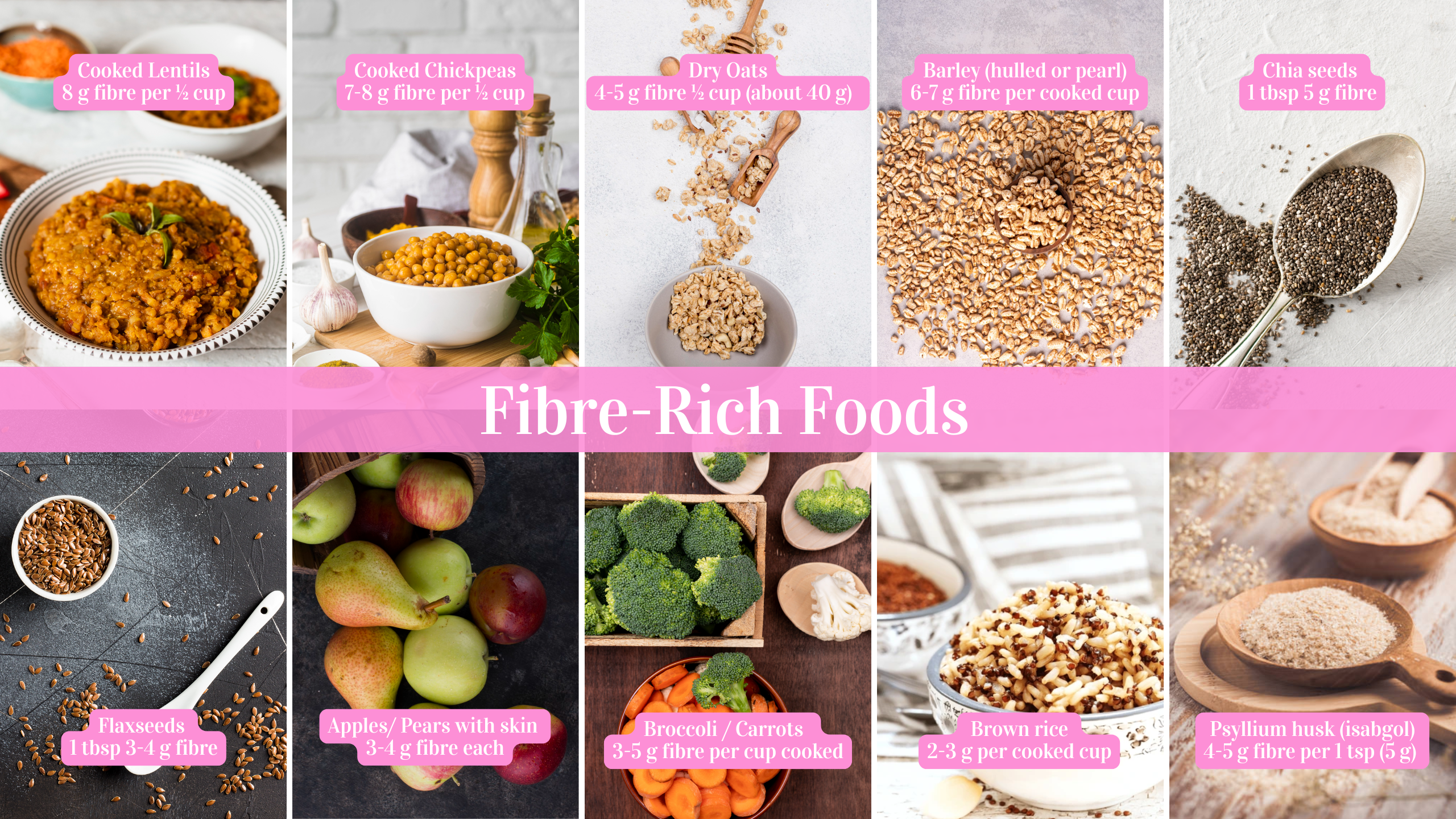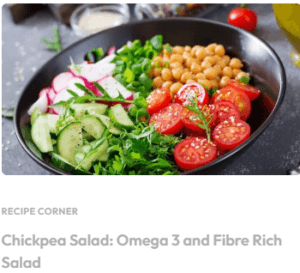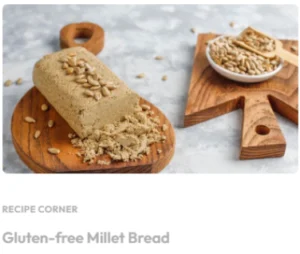Fibre Power: 8 Great Reasons to Add it to your Daily Diet

Table of Contents
The Fibre Comeback: Why This Nutrient Deserves Your Attention
Fibre may once have seemed like a “whispered” nutrient, mentioned in passing as “eat your whole grain” or “have more vegetables for fibre”. But in 2025 it is roaring back into the spotlight as a resurgent super nutrient. From boosting gut health to supporting metabolism, cardiovascular health, and even immune function, it is rediscovered and celebrated for all the right reasons.
If you’ve ever wondered why fiber deserves more than just a casual mention or how to truly make it work for you rather than just meeting a daily quota, you’re in the right place. This article is your go-to guide for everything. You’ll find out why it’s essential, the different types it comes in, how your body processes it, and what it can do for your health, and bust some common myths. Consider this your ultimate “fibre facts deep dive,” equipping you to harness this powerful nutrient in a meaningful way.
1. Why Fibre Matters?
Let’s be honest: when people hear “fibre,” they often think of digestion and regular bowel movements. But it is about so much more than that; it’s a nutrient that impacts many areas of our overall wellbeing. Here’s why it’s more important today than ever:
▪️It remains under-consumed. Despite its many benefits, many people aren’t getting enough in their diets. In various countries, average fiber intake remains well below recommended levels. This means a lot of people are missing out on an easy health boost by neglecting their fibre intake.
▪️It affects gut health, metabolism and beyond. Fibre plays a significant role in gut health, metabolism, and beyond. It helps regulate many bodily functions, from transit time (from the moment you eat your food until waste is excreted) and satiety to blood sugar management and lipid metabolism. It even nurtures your gut microbiome, the trillions of bacteria that call your digestive tract, acting as a natural prebiotic to support their growth.
▪️Fibre is part of the metabolic orchestra. Recent studies have uncovered fascinating roles that different types play in our bodies. For instance, fermentable fibers like inulin have been shown to suppress fat creation while boosting fat oxidation through interactions with our gut microbiota.
Reference : Nature : Dietary fibre-adapted gut microbiome clears dietary fructose and reverses hepatic steatosis
So, fibre isn’t just roughage; it’s a dynamic nutrient with systemic benefits. Failing to include enough in your diet is akin to missing out on a golden opportunity for better health. If you’re looking for improved gut health, better metabolic function, heart health, or even a stronger immune system, it should be at the forefront of your dietary choices.
2. Types of Fibre
Not all fibre is formed similarly. In fact, the different types provide different physiological benefits. To get the most from fiber, it helps to know the categories and how they differ.
▪️Soluble Fibre
This type dissolves in water, forming a gel-like substance. Think oats (hello beta-glucan!), psyllium, and pectins found in fruits. It is fantastic at slowing down gastric emptying, moderating glucose absorption, and even binding bile acids to help lower LDL cholesterol.
▪️Insoluble Fibre
Unlike soluble fibre, this type doesn’t dissolve in water. It adds bulk to your diet and speeds up the transit time through your large intestine. You’ll find it in cellulose, wheat bran, and whole grain kernels. It is essential for promoting regularity, preventing constipation, and supporting the health of your large bowel.
▪️Fermentable/ Prebiotic Fibre
Fermentable fibres are the food your gut bacteria! They can be fermented by the friendly bacteria in your intestines. Examples include inulin, fructo-oligosaccharides (FOS), and resistant starch. They produce short-chain fatty acids (SCFAs) like acetate, propionate, and butyrate, which nourish your gut lining, bolster your immune system, and can even enhance metabolic function.
▪️Resistant Starch
This is a special form of starch that resists digestion in the small intestine, acting like fibre. You’ll find it in foods like cooled cooked potatoes, green bananas, and certain whole grains. Resistant starch behaves similarly to fermentable fibers, feeding gut bacteria and increasing the production of SCFAs while also possibly improving insulin sensitivity.
▪️Viscous vs Non-viscous Fibre
Viscous fibres (think psyllium) form thick gels and tend to have more potent effects on cholesterol and blood sugar control compared to non-viscous fibers, alongside its dose and frequency of intake, can really shape the benefits you experience.
3. Metabolism: How Fibre is Processed in the Body
Understanding what happens in your body after you consume fibre clarifies why the type you eat and how you eat it makes a difference. Here’s a closer look at the journey:
Step-by-Step Journey
1. Ingestion & passage : Once you eat fiber, it travels through your stomach and small intestine, often left unchanged, as many it resist digestion by human enzymes.
2. Fermentation and transit : After reaching the large intestine (or colon), the magic begins. Fermentable fibers become food for gut bacteria, while insoluble fibers add bulk to your stool and help move it along.
3. Production of SCFAs (Short-Chain Fatty Acids). Beneficial bacteria work their magic by fermenting fiber into SCFAs; like butyrate, propionate, and acetate. These SCFAs are absorbed and utilized by your body. For instance, butyrate supplies energy for colon cells, propionate may influence gluconeogenesis in the liver, and acetate has a broader array of uses.
Research indicates that fiber-rich diets enable gut microbes to contribute approximately 2-5% of daily energy via SCFA absorption, pretty impressive!
Reference : News-Medical : New research reveals why fiber-rich diets fuel you better than refined foods
Secondary metabolic effects.
1. Gel-forming soluble fibers slow glucose absorption → lower post-meal spikes.
2. Soluble fibers bind bile acids → more cholesterol is used to replace them → lower LDL.
3. Fermentable fibers and their SCFAs can influence hormones such as GLP-1 and PYY → improved satiety and better glucose regulation.
Research shows inulin supplementation led to increased fat-oxidation and suppressed hepatic lipogenesis via gut-microbiome pathways.
Reference : Nature : Dietary fibre-adapted gut microbiome clears dietary fructose and reverses hepatic steatosis
4. Excretion and stool bulk. Non-fermentable adds bulk and water to stool, improves transit time and supports bowel regularity.
Why does this matter to you?
~ The speed and quality of digestion and absorption are improved.
~ The microbiome can shift to more beneficial bacteria with higher intake.
~ Your metabolism and energy homeostasis get positive modulation not just via “calories in vs calories out” but via hormonal, microbial, and gut-route mechanisms.
~ It supports clearance processes (dietary and microbial) and can impact immune and barrier functions.
In short: It isn’t just “roughage” that passes through, it actively engages with your body’s internal systems.
4. Health & Nutrition Benefits
Below are the major health and nutrition benefits backed by research, some of which are beyond what many people expect.
▪️Digestive Health & Regularity
One of the most established benefits: it improves stool bulk, consistency and frequency. Insoluble-fibre helps speed up transit; soluble-fibre softens stool; fermentable-fibre feeds bacteria that maintain gut-barrier health.
The RCT in healthy adults found high fiber intake (8.2 g/day extra) significantly improved bowel-related quality‐of‐life scores and shifted beneficial genera such as Anaerostipes, Bifidobacterium and Fusicatenibacter.
▪️Cardiovascular Health
Soluble viscous-fibre can bind bile acids, leading to more cholesterol being used for bile production, thereby lowering LDL (“bad”) cholesterol. Observational and interventional data show that higher intakes are associated with reduced heart disease risk.
▪️Glycemic Control & Metabolic Health
It slows absorption of carbohydrates, attenuates post-meal glucose spikes and improves insulin sensitivity.
The research review noted that fiber-rich interventions enriched SCFA-producing bacteria, which in turn have relationships with metabolic syndrome, type 2 diabetes and cardiovascular health.
Reference : Frontiers : Gut microbiome-mediated health effects of fiber and polyphenol-rich dietary interventions
▪️Weight Management & Satiety
By increasing the volume of food, slowing digestion, and promoting gut-hormones such as GLP-1/PYY (via fermentation), it helps you feel fuller for longer. It’s not a “magic weight-loss pill” but is a powerful tool in a weight‐control strategy.
▪️Microbiome & Immune Health
High-fiber diets have been shown to increase beneficial bacteria (such as Faecalibacterium, Roseburia, Blautia) and increase SCFAs, which support gut-barrier integrity, immune regulation and may reduce inflammation.
A study found that a fiber-rich diet helped reduce the likelihood of serious gut-pathogen colonisation, since beneficial bacteria from fiber consumption protect against Enterobacteriaceae overgrowth.
▪️Emerging/Experimental Benefits
Is fibre just a trend? Not at all! New research suggests that it could play a role in cleansing our bodies and improving liver health. Plus, older adults can greatly benefit from it and polyphenol-rich diets, enhancing their gut health as they age. It’s uplifting to know that such a simple nutrient could have profound effects on our well-being!
5. Psyllium Husk : From “Isabgol” to “Natural Ozempic”

Let’s talk about a fiber superstar that’s buzzing in wellness circles: psyllium husk (also known as isabgol in India). Recently dubbed a “natural equivalent” to GLP-1 medications like Ozempic for weight loss, psyllium has caught the attention of health enthusiasts. But before you get too excited, let’s clear things up. While psyllium is indeed beneficial, it’s not a substitute for medications. However, as a soluble fiber, it works wonders when combined with plenty of water. Drink up, and let this gel-forming powerhouse enhance your dietary fiber intake!
What to know:
~ Yes, psyllium has legitimate benefits (via soluble viscous fiber) and is an easy way to increase.
~ No, it does not replicate the pharmacological potency of GLP-1 medications.
~ You must use adequate water alongside it. If taken with little fluid, viscous fibers can risk obstruction.
It works best as part of an overall fiber-rich diet, not as a “single supplement fix”.
Check out Our Instagram Post to know more

6. Ways to Incorporate Fibre in Your Diet
Now that we’ve established the importance, the big question is: how can you integrate more of it into your daily routine? Here are some simple, practical tips:
Start Gradually & Hydrate
If you’re currently eating low fiber (say 10-15 g/day), don’t jump to 40 g overnight. Increase gradually (e.g., +3-5 g every few days) to minimize gas or bloating. Also, as intake increases, especially the gel-forming and bulk-forming, make sure you are drinking adequate water (aim for 30-35 ml/kg body weight or almost 2.5-3 L/day for many adults, adjusted for climate/size).
Add a Fibre-Swap at Each Meal
Breakfast: Swap white bread/muffin to whole-grain oats or whole-wheat toast. Add a tablespoon of chia/flax seeds.
Lunch: Use whole-grain roti/rice/quinoa instead of white rice. Add a side salad or cooked legumes.
Dinner: Include legumes (kidney beans, chickpeas, lentils) 2-3 times/week; add vegetables with skin.
Snacks: Replace a low-fibre snack (e.g., plain biscuit) with hummus + veggie sticks, roasted chickpeas, or an apple + nut butter.
Focus on Variety
Aim for both soluble and insoluble-fibre, and some fermentable-fibre. That means combine: whole grains + legumes + fruits/vegetables + seeds + some resistant starch (cooled cooked potatoes, green banana). Diversity of their sources supports a richer microbiome and broader benefits.
Use Meal Planning & Tracking
You might log it in grams for a week to see what your baseline is. Then set a realistic incremental target (for example, add 10 g/day). Use a kitchen scale, diet tracking tool or simple estimate.
Overcome Barriers
~ If you dislike whole grains, try mixing in small amounts and increasing gradually.
~ If digestion is slow or you have IBS: choose low-fermentable ones initially, and consider working with a nutritionist or a healthcare professional.
~ If you eat out frequently, ask for whole grain options, include sides of pulses or salad, and choose snacks.
Use Supplement/Added Fibre When Needed
If your diet still lacks fiber due to schedule, digestion issues or appetite constraints, consider using a supplement (like psyllium husk) in addition to food. Example: 1 teaspoon of psyllium husk stirred in water before a meal. But still aim to get the majority through whole-food.
Sample One Day Fibre Boost Menu
Breakfast: Rolled oats cooked in milk + 1 tbsp chia seeds + berries
Mid-morning snack: Apple with skin + handful of almonds
Lunch: Whole-wheat roti + vegetable curry + ½ cup chickpeas
Afternoon snack: Roasted chickpeas or hummus + carrot sticks
Evening: Small bowl of popcorn (air-popped)
Dinner: Brown rice/quinoa + cooked broccoli + lentils
7. Top 10 Fibre-Rich Foods
Here are ten foods that deliver high fibre, are actionable, and relevant for a global/Indian context. Aim to include many of them across your week.

Tip: Mix and match. For example, have lentils one day, barley another, seeds and fruit throughout. That ensures you hit both the quantity and diversity.
Below are few recipes to try out
8. Myth-Busting
Let’s clear up some common misunderstandings.
Myth 1: “All fibre is the same.”
Reality: No. Types differ in solubility, viscosity, fermentability, and physiological impact. Some bulk stool (insoluble), others slow digestion (soluble), and others feed your microbiome (fermentable). The benefits you get (cholesterol lowering, glucose modulation, stool regularity) depend on the type. That’s why variety is important.
Myth 2: “If I take a fibre supplement, I don’t need to eat high-fibre foods.”
Reality: Not quite true. Supplements like psyllium can help, but whole-food fibers bring additional nutrients (vitamins, minerals, polyphenols), more diverse types and food matrix benefits. Use supplements only as an extra, not instead of good foods.
Myth 3: “Fibre alone will manage your weight.”
Reality: Fiber is a helpful tool for weight management (via increased satiety, slower digestion), but it does not override calories, physical activity, sleep, hormones or dietary quality. If you eat excessive calories from refined foods plus supplements, you won’t automatically lose weight. Think of it as one part of a broader healthy-living strategy.
Myth 4: “I can add a lot of fibre overnight with no side effects.”
Reality: Rapid jumps in fiber intake (especially fermentable) can cause gas, bloating, and discomfort. That’s why the “start low, go slow” principle applies. Hydration matters too. And if you have digestive conditions (IBS, SIBO, prior GI surgery), you may need guidance.
Myth 5: “More fibre is always better.”
Reality: While higher fiber intake is associated with many benefits, extremes (e.g., extremely high doses without liquids) may cause issues (e.g., reduced mineral absorption, excessive gas, reduced meal energy intake if not balanced). For most adults, an intake of 25–40 g/day (or more depending on age/size) is a good target, but extremely high intakes must be balanced and monitored individually.
Final Thought
Fibre is far from being a dusty old nutrition topic, it is very much a resurgent super nutrient. The science is clear: it supports gut health, metabolism, your microbiome, regularity and beyond. The key is to approach it smartly: choose diverse types, incorporate through whole foods, supplement if necessary (e.g., psyllium), and combine with healthy hydration and diet/lifestyle patterns. Start today: swap one food for a whole-grain, add a tablespoon of seeds, and use legumes twice this week. Over time, you’ll feel the difference; fiber becomes the quiet hero of your plate.
Frequently Asked Questions (FAQs)
1. How much fibre should I aim for each day?
While recommendations vary by country and age, a general target for healthy adults is 25-35 g per day or more, depending on your size and needs. Many people eat much less. Gradually increasing intake (and tracking) is wise.
2. Can I rely solely on fibre supplements instead of fibre-rich foods?
NO! Supplements (e.g., psyllium husk) can help, especially if your diet is low in fiber or you experience stool irregularity, but they should complement high-fiber foods, not replace them. Whole-foods bring other nutrients and greater variety.
3. What should I do if I experience gas or bloating after increasing fibre?
It’s common when fiber increases rapidly. The best approach: increase gradually, make sure you’re drinking sufficient water, choose less fermentable fibers initially (insoluble or bulk-forming) and add fermentable slowly. If you have a GI condition (IBS, SIBO), consult your healthcare professional.
4. Does the type of fibre matter (soluble vs insoluble vs fermentable)?
Yes, different types deliver different benefits. Soluble fiber is best for cholesterol/glucose; insoluble is best for transit/regularity; fermentable fiber supports your microbiome and produces SCFAs. A mixed approach is ideal.
5. Can children or older adults also benefit from higher fibre?
Absolutely, it is important across the lifespan. For children, it supports healthy bowel habits and microbiome; for older adults, it helps maintain gut health, microbiome diversity, and may support healthy ageing. Always tailor to age, appetite and digestive capacity.
Disclaimer : This content is for informational purposes only and is not a substitute for professional medical advice, diagnosis, or treatment. Always consult a qualified healthcare provider for any questions or concerns regarding your health.
References :
1. News-Medical. (2025, July 31). New research reveals why fiber-rich diets fuel you better than refined foods. https://www.news-medical.net/news/20250731/New-research-reveals-why-fiber-rich-diets-fuel-you-better-than-refined-foods.aspx
2. Jung, S., Bae, H., Song, WS. et al. Dietary fibre-adapted gut microbiome clears dietary fructose and reverses hepatic steatosis. Nat Metab 7, 1801–1818 (2025). https://doi.org/10.1038/s42255-025-01356-0
3. Inoue, R., Suzuki, K., Takaoka, M., Narumi, M., & Naito, Y. (2025). Effects of Dietary Fiber Supplementation on Gut Microbiota and Bowel Function in Healthy Adults: A Randomized Controlled Trial. Microorganisms, 13(9), 2068. https://doi.org/10.3390/microorganisms13092068
4. Meiners F, Ortega-Matienzo A, Fuellen G and Barrantes I (2025) Gut microbiome-mediated health effects of fiber and polyphenol-rich dietary interventions. Front. Nutr. 12:1647740. doi: 10.3389/fnut.2025.1647740
5. Feeding your good gut bacteria through fibre in diet may boost body. (2025, January 10). University of Cambridge. https://www.cam.ac.uk/research/news/feeding-your-good-gut-bacteria-through-fibre-in-diet-may-boost-body-against-infections


